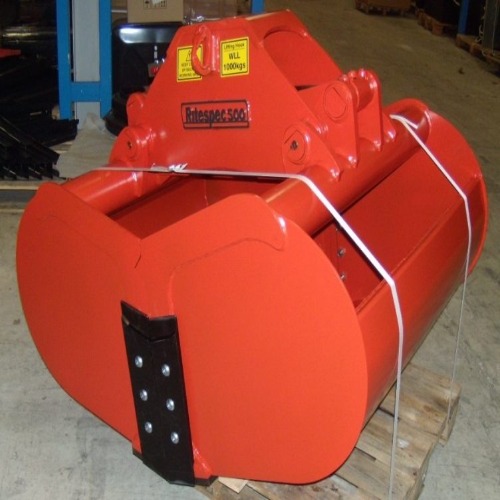Call us on +44 (0)1327 842808 |
Published on 26 June 2022
Are you new to construction and materials movement and struggling to come to terms with some of the jargon? If so, you’re not alone. There are seemingly endless types of equipment and accessories for you to choose from to get the job done, making it hard to know what the differences are and where you should be looking.
One of the most efficient and versatile tools is the clamshell bucket. If you’ve ever seen a grab loader or been on a construction site, you’ll have likely seen a clamshell bucket, but you may not be able to picture one off the bat. If you’ve ever wondered ‘what is a clamshell bucket?’ or whether you could make use one, ponder no more.
In this blog, we’ll cover everything you need to know about this handy attachment, so keep reading to find out more about clamshell buckets and how they could work for you.

Let’s start with the basics. Clamshell buckets get their name from their shape. They’re comprised of two sides that are joined together with a centre hinge, resulting in an attachment that opens and closes just like a clam in the sea. The two shells work in synchronous movement put in motion by hydraulic cylinders. These attachments are most suitable for materials handling and loading of gravel, sand and earth.
They can be mounted on a wide range of machines, such as truck cranes, backhoe loaders, mini excavators, agricultural machines and material handlers.
In addition to picking things up, clamshell buckets are also used for some digging work if supplied with the correct accessories, teeth or cutting edges , including below ground. Due to their shape and the way the bucket closes, they can hold a good amount of dirt and aggregate when needed.
Adding to their versatility is their ability to place items at height and move items across a construction site. With so many uses, they’re commonplace on most building sites for the duration of the work being carried out.
Generally speaking, clamshell buckets are attached to excavation equipment, but can also be attached to cranes and blackhoes. As mentioned, there are light and heavy-duty options, as well as hydraulic and mechanical options.
There are a few different types of clamshell buckets you’re likely to come across, and the type you need will depend on your project and the machine you’re operating. The main types of clamshell buckets are:
There are other types of clamshell buckets available, including electrohydraulic clamshell buckets and rehandling clamshell buckets, all of which come from a range of suppliers. Ritespec offers one of the best and most reliable ranges of clamshell buckets in the UK, with quality and longevity at the forefront of the design.
If you’re unsure what type of clamshell bucket might be best for your needs, or which one could be compatible with your machine, get in touch with the PCM Handling team.
Did you know that for the last 20 years, PCM Transport and Handling has been working with Tizmar SNC in Italy to produce the Ritespec Clamshell bucket? We are the only UK importer of Ritespec products, meaning you’ll only ever get the real deal when you shop with us. We don’t import cheap alternatives – we are proud to stock authentic Ritespec buckets make specifically for the UK market.
We stock a wide range of Ritespec clamshell buckets, ranging from 100l to 500l. Our team is highly knowledgeable and experienced and poised to help you find the best solution. If you don’t know which clamshell bucket is the best option for your needs, simply call us on 01327 842 808 and a member of our team will be happy to help you find the best solution for your project.
Fill in the form below and a member of the team will be in touch with you shortly.
© 2025 PCM Transport and Handling
Web Design and Marketing by Loop Digital